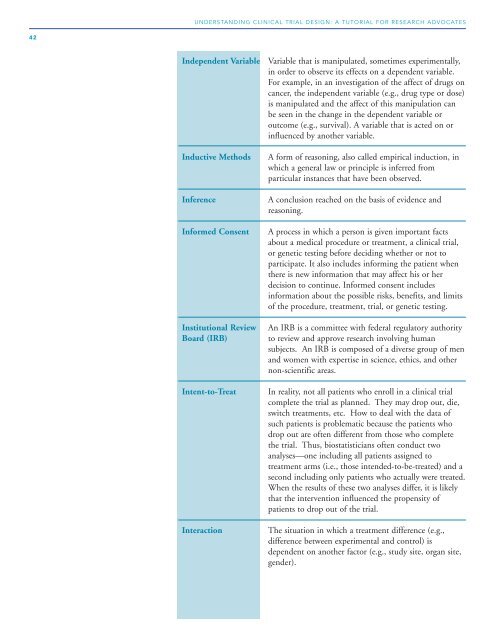Understanding Clinical Trial Design - Research Advocacy Network
Understanding Clinical Trial Design - Research Advocacy Network
Understanding Clinical Trial Design - Research Advocacy Network
Create successful ePaper yourself
Turn your PDF publications into a flip-book with our unique Google optimized e-Paper software.
42<br />
UNDERSTANDING CLINICAL TRIAL DESIGN: A TUTORIAL FOR RESEARCH ADVOCATES<br />
Independent Variable Variable that is manipulated, sometimes experimentally,<br />
in order to observe its effects on a dependent variable.<br />
For example, in an investigation of the affect of drugs on<br />
cancer, the independent variable (e.g., drug type or dose)<br />
is manipulated and the affect of this manipulation can<br />
be seen in the change in the dependent variable or<br />
outcome (e.g., survival). A variable that is acted on or<br />
influenced by another variable.<br />
Inductive Methods A form of reasoning, also called empirical induction, in<br />
which a general law or principle is inferred from<br />
particular instances that have been observed.<br />
Inference A conclusion reached on the basis of evidence and<br />
reasoning.<br />
Informed Consent A process in which a person is given important facts<br />
about a medical procedure or treatment, a clinical trial,<br />
or genetic testing before deciding whether or not to<br />
participate. It also includes informing the patient when<br />
there is new information that may affect his or her<br />
decision to continue. Informed consent includes<br />
information about the possible risks, benefits, and limits<br />
of the procedure, treatment, trial, or genetic testing.<br />
Institutional Review An IRB is a committee with federal regulatory authority<br />
Board (IRB) to review and approve research involving human<br />
subjects. An IRB is composed of a diverse group of men<br />
and women with expertise in science, ethics, and other<br />
non-scientific areas.<br />
Intent-to-Treat In reality, not all patients who enroll in a clinical trial<br />
complete the trial as planned. They may drop out, die,<br />
switch treatments, etc. How to deal with the data of<br />
such patients is problematic because the patients who<br />
drop out are often different from those who complete<br />
the trial. Thus, biostatisticians often conduct two<br />
analyses—one including all patients assigned to<br />
treatment arms (i.e., those intended-to-be-treated) and a<br />
second including only patients who actually were treated.<br />
When the results of these two analyses differ, it is likely<br />
that the intervention influenced the propensity of<br />
patients to drop out of the trial.<br />
Interaction The situation in which a treatment difference (e.g.,<br />
difference between experimental and control) is<br />
dependent on another factor (e.g., study site, organ site,<br />
gender).


